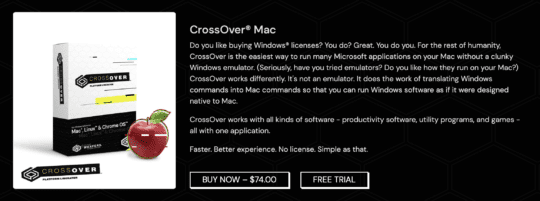In the past, I’ve written a bit on the challenges of gaming on a Mac (see here and here). And while it is possible, there has always been a glaring problem: Most games aren’t designed to run on Mac. That’s why we’re going to be looking at Crossover vs Parallels in today’s post.
For those that don’t know, these two apps are designed to help you run Windows apps on your Mac. They work in different ways (which I’ll cover shortly). But the ultimate result is the same. By using one of these apps, you should be able to use Windows apps on your Mac computer.
Of course, while I have and will mostly be talking about these apps in the context of gaming, you can use these apps as a means of accessing Windows apps on your Mac. The reason I am talking about them through the lens of gaming is that one, games are pretty power-intensive, so they’re a good way to test the effectiveness of these apps. And two, most people who have a need to use Windows apps on their Mac are doing so for gaming.
That said, if you’re a professional who needs to access certain apps for school or work, this article will also help you decide which of these two apps to invest in.
Contents
Crossover vs Parallels: Why do you need one of these apps?
As mentioned, we’re going to kick off this Crossover vs Parallels comparison by discussing what each app does. And to do that, we’re going to explore why you need these apps in the first place.
The vast majority of games aren’t designed to work with Mac
To me, the primary reason for using either Crossover vs Parallels is that the vast majority of games on services like Steam simply aren’t available on Mac. I learned this the hard way whenever I bought my new M1 iMac a few years ago and decided to test its performance while gaming.
While doing this testing, I discovered that very, very few of the games I had initially planned on testing were able to work on my machine. And that isn’t even because I’m using an M1 iMac. They weren’t available on any Mac machines, Intel or otherwise.
So if you want to play more than a handful of games on your Mac and you aren’t interested in or able to grab a PC, one of these tools is going to be your best bet.
Bootcamp isn’t available on newer Macs anymore
In the past, you used to be able to use a Mac feature known as Bootcamp. This would allow you to install Windows on your Mac. Then, when you turn your Mac on, you could choose to boot up Windows or macOS. It was the best of both worlds.
Unfortunately, the new M-Series Macs (which are virtually all new Macs at this point) use ARM architecture. There’s a lot of complicated reasons for this, but all you really need to know is that Windows can’t be installed on a chip with ARM architecture. At least not without a lot of know-how. And if you’re reading this article, then I assume that you (like me) don’t have that know-how.
So without Bootcamp, we’re left using apps like Crossover vs Parallels.
Crossover allows you to run Windows apps on your Mac
Of course, if Crossover vs Parallels worked exactly the same, there would be little point in making this post. They’re actually pretty different, though, so let’s briefly touch on how each of these apps works.

Crossover is basically a translation app. If an app has been written to work in Windows, you can install that app on your Mac and Crossover will allow you to open it. Without Crossover, you really wouldn’t be able to download these apps at all, let alone open them.
Now, because Crossover is translating these Windows apps to run on your Mac, it’s not going to work for everything. You’ll occasionally bump into apps that Crossover hasn’t been made to run yet. When that happens, Crossover simply won’t be useful to you.
When Crossover does work, though (and in my experience it usually works), the apps run pretty fast.
Parallels allows you to run Windows on your Mac
Parallels, on the other hand, is an app that allows you to run Windows on your Mac in a virtual environment. For those not familiar with a virtual environment, it’s essentially like running Windows (or another OS) in a window on your Mac. So you open Parallels, and a window appears with the Windows OS inside it.

You can then download and install Windows apps within Parallels desktop, access them within that window, and so on. Whenever you’re done, you just close the Parallels window and you’re back to using your Mac like normal.
This is basically an alternative to Bootcamp, a Mac feature that isn’t available on newer M-Series Macs. It’s great for developers, and it more or less ensures that you can run any Windows app on your Mac. However, you’ll probably experience a performance decrease most of the time. That’s because virtual environments are kind of usage intensive.
Crossover vs Parallels: A head-to-head comparison
And with that, we’re ready to dive into our Crossover vs Parallels head-to-head comparison. I’m going to be covering the strengths and weaknesses of each of these apps, because the truth is that neither is necessarily better than the other. It just comes down to what you’re trying to get out of these apps and the Windows apps you want to be able to run.
Crossover is more affordable, but both are pricey
The first thing that’s worth mentioning in the Crossover vs Parallels conversation is that Crossover is slightly more affordable, at least upfront. It uses an annual subscription, while Parallels allows you to buy the app outright and then pay a smaller (but still high fee) for upgrades.
Here are the current prices for these two apps:
- Crossover is $74/year, but there is a 14-day free trial
- Parallels is $99 for new, standard users; you can pay more for higher performance depending on your needs. Whenever a new version of Parallels comes out, you’ll need to spend $69 to keep it current.
That means that you can expect to pay $74/year for Crossover, while Parallels will cost around $56/year if you distribute upgrades every two years. At the end of the day, that’s not much of a difference.
To use Parallels, you’ll need to buy Windows
That being said, there is an extra upfront cost to Parallels, and that’s the fact that you need to pay for Windows. That’s because Parallels is a virtual environment, and for that virtual environment to have Windows installed, you need to purchase a Windows license.
Crossover, on the other hand, is just translating Windows apps to work on macOS. No Windows purchase necessary.
Again, this can slightly add to the long-term cost of Parallels, but it’s more so an upfront cost since Windows doesn’t come out with new, paid versions too often.
Crossover is going to be a lot faster
Another notch in Crossover’s favor in the Crossover vs Parallels debate is its performance. If you’re running both apps on a high-performance Mac (i.e., your Mac is a newer model with an M-Series chip) then you should get all of the performance you need either way.
But if you’re trying to maximize your performance, I would go with Crossover. That’s because Crossover isn’t recreating and running a Windows environment on top of your macOS environment. It’s just helping you run the apps you want to run.
Conversely, Parallels has a lot more to keep up with. It’s essentially running two computers simultaneously, which can really eat up your computer’s performance. Now, it is pretty optimized. That’s why we’re talking about Parallels and not one of the other plethora of VMs out there.
Still, if you’re planning on using super intensive apps, Crossover might be slightly more ideal.
Parallels is going to support far more Windows apps
On the other hand, while Parallels might not be as fast as Crossover, it’s going to support far more apps. That’s because, for Crossover, each app that it runs has to essentially be manually supported by it. The developers have to go, “Ok, a lot of our users want to use this app, so let’s add support for it in Crossover”.
Meanwhile, Parallels is recreating a Windows environment. So if an app can run on Windows, it can run in Parallels. Simple as that. You can check which apps are available on Crossover in this database. I would make a list of the apps that you want to use and start checking if Crossover supports them.
The good news is that Crossover will basically support most popular apps and games. You shouldn’t have a hard time finding support in Crossover for a game or app you like. But if it’s more obscure, or you’re in a situation where you need one app or program installed so that you can do XYZ in another app, and for that you’ll also need some Windows-exclusive service to be supported – yeah, Crossover is probably going to let you down.
If you’re worried about simplicity, avoid Crossover
A knock against Crossover in the Crossover vs Parallels conversation is that it isn’t very intuitive. Well, if we’re being fair, neither of these apps is all that intuitive. You’re going to need to be relatively tech-savvy either way.
But in my experience, Crossover is the less intuitive app. It’s finicky, launching apps through it is a bit annoying, and it’s just overall a bit of a hassle.
Parallels, on the other hand, does have a learning curve. But it’s the same learning curve that will come with any virtual environment. If the concept of a VM is foreign to you, then it might take a while to wrap your head around. After a few days of using it, though, it should click.
Crossover, however, never really clicked for me. And that’s largely because getting each app to work with Crossover posed unique challenges. Some apps just work, while others require you to tinker with the app. You never really know which it’s going to be until you try using a particular app.
If you need everything to work, try Parallels
The last major point I want to cover in this Crossover vs Parallels conversation is that Parallels really covers everything. It’s extremely comprehensive. If you’re looking to do more than just game on some Windows-exclusive apps, then you’re going to want to go with Parallels.
You’ll be able to install all sorts of weird little apps and services, programming languages, and so on. It’s basically like having a Windows computer installed on your Mac.
On top of making gaming not too difficult, it gives you a lot to work with. So if you’re a developer, need to use certain apps for school or work, etc., then I highly recommend Parallels.
Crossover vs Parallels: Which should you go with?
Alright, now we come to the portion of our Crossover vs Parallels article where we suggest which one is right for which users. By now, you should have a pretty good idea of which is right for you, but just in case, here’s my two cents.
Tech savvy gamers should stick with Crossover
If you’re relatively tech-savvy and you’re just looking to play Windows games on your Mac, go with Crossover. Sure, it’ll be a bit annoying to get some apps working sometimes. But you’ll probably be able to get the hang of it, and those games will run better than they will in Parallels.
Just make sure that you check the games you want to play against the Crossover database. The last thing you want is to go with Crossover, only to realize that it doesn’t support your favorite game.
Developers, professionals, and casual games should go with Parallels
For everyone else, I’d recommend Parallels. You’ll still be able to play Windows games, and the performance will be fine. You may have to cut down on graphics every now and then, but at the end of the day, that’s not so bad.
And you’ll have the ability to really dive into the Windows experience. That means developing and testing apps, installing and toying with all sorts of obscure software, and being able to keep up with your PC-owning colleagues without missing a beat.
Crossover vs Parallels: Are there any other options out there?
Before closing out this article on the differences between Crossover vs Parallels, I did want to address a question that I’m sure many of you have: Are there any better options out there?
In my experience, not really. Parallels is one of the best Windows emulators around, with great performance and ease of use. Sure, there are a hundred and one Windows emulators out there, and many of them free. But if you care about performance at all, you’re going to want to spend the cash on Parallels.
The same goes for Crossover. There are a handful of other apps that do what Crossover do, but most of them don’t have the same level of support. And in my experience, none of them were as easy to use as Crossover. I gave up on nearly all of them before I got anywhere close to getting a Windows app to work with them.
And as mentioned at the start of the article, Bootcamp is basically gone, as sad as it is. So these sorts of solutions are all Mac users really have left. Unless you want to grab a PC, of course, which I actually recommend if you want to game on a computer. I tried to make Mac gaming work for a few months, and eventually I gave in and bought a PS4. It just wasn’t worth it.
Crossover vs Parallels: Which are you going with?
And that’s it! Those are my thoughts on the pros and cons of Crossover vs Parallels. In the end, both are going to be pretty good solutions. It just comes down to what your specific needs are. Let me know which one you’re thinking about going with in the comments below!
For more insights, news, and guides on all things Apple, check out the rest of the AppleToolBox blog.
See you next time!










Write a Comment